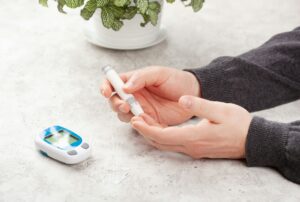Monitoring your blood sugar at home is a critical component of managing diabetes and ensuring overall well-being. Whether you’re dealing with Type 1 diabetes, Type 2 diabetes, gestational diabetes, or pre-diabetes, keeping track of your blood glucose levels can help you make informed decisions about medication, diet, and lifestyle changes. This blog post provides an in-depth guide on how to effectively monitor your blood sugar at home.
Understanding Blood Sugar Levels
Before diving into the monitoring process, it’s essential to understand what blood sugar levels indicate. Blood sugar, or glucose, is the main sugar found in your blood and is your body’s primary source of energy. These levels fluctuate throughout the day due to various factors like food intake, physical activity, and even stress.
For people with diabetes, maintaining target blood sugar levels is crucial to avoid both short-term issues like hypoglycemia (low blood sugar) and hyperglycemia (high blood sugar) and long-term complications such as nerve damage, heart disease, and kidney problems.
Why Monitor Blood Sugar at Home?
Home monitoring of blood sugar levels allows for:
- Immediate feedback on the impact of foods and activities on your blood sugar levels.
- Better management of medication doses, particularly insulin.
- Early detection of dangerously high or low blood sugar levels, allowing for prompt corrective action.
- Collaborative tracking for more effective consultations with healthcare providers.
Tools You Need
To effectively monitor your blood sugar at home, you will need some essential tools:
- Blood Glucose Meter: This device measures your blood sugar levels using a small drop of blood.
- Test Strips: These are used in conjunction with the glucose meter to provide the reading.
- Lancet Device: This small, spring-loaded device holds the lancet, a tiny needle used to prick your finger and obtain a blood sample.
- Control Solution: This helps you ensure that your meter and test strips are working correctly.
- Logbook or Mobile App: Tracking your readings over time is essential for effective management.
Step-by-Step Guide to Monitoring Blood Sugar
Here’s a detailed step-by-step guide to help you accurately monitor your blood sugar levels:
Step 1: Gather Your Supplies
Before you begin, wash your hands thoroughly with soap and water and dry them well. This helps to prevent any potential contaminants from affecting your reading. Gather your glucose meter, test strips, lancet device, and a logbook or mobile app for recording your results.
Step 2: Insert a Test Strip
Place a new test strip into your glucose meter. Some meters may power on automatically when you do this, while others may require you to press a button. Check your meter’s manual for specific instructions.
Step 3: Prepare the Lancet Device
Insert a new lancet into your lancet device and adjust the depth setting according to your skin type. A shallower depth may be sufficient for those with thin or delicate skin, while thicker skin may require a deeper setting.
Step 4: Prick Your Finger
Choose a finger (typically the side of your fingertip) and use the lancet device to prick it, drawing a small drop of blood. Gently squeeze your finger if necessary to produce the drop.
Step 5: Apply Blood to the Test Strip
Touch the edge of the test strip to the drop of blood, allowing it to absorb and fill the strip. The meter will then process the sample and display your blood glucose level within seconds.
Step 6: Record Your Results
Note down the reading in your logbook or input it into a mobile app designed for tracking blood sugar levels. Include additional details such as the date, time, food intake, and any medications taken.
Step 7: Dispose of the Lancet and Test Strip
Safely dispose of the used lancet and test strip in a designated sharps or biohazard container. Never reuse lancets or test strips.
Interpreting Your Readings
Understanding the meaning behind your readings is crucial for effective diabetes management. Here are some general target ranges (check with your healthcare provider for your specific targets):
- Fasting (before meals): 80-130 mg/dL
- 1-2 hours after meals: Less than 180 mg/dL
- Bedtime: 100-140 mg/dL
Consistently high readings may indicate the need for adjustments in medication, dietary habits, or lifestyle changes, while consistently low readings could suggest the need to modify your treatment plan to prevent hypoglycemia.
When to Check Your Blood Sugar
The frequency and timing of your blood sugar checks will depend on several factors, including the type of diabetes you have, your treatment plan, and your individual needs. Common times to check blood sugar levels include:
- Before and after meals
- Before and after exercise
- Before bedtime
- When you feel symptoms of hypoglycemia or hyperglycemia
- As advised by your healthcare provider
Tips for Accurate Monitoring
To ensure you are getting accurate readings, consider the following tips:
- Check the expiration dates on your test strips and control solutions.
- Store your glucose meter and test strips in a cool, dry place.
- Calibrate your meter regularly according to the manufacturer’s instructions.
- Compare your meter results with lab results periodically to ensure accuracy.
- Avoid using alcohol swabs, as some meters can be affected by residue; clean hands with soap and water instead.
Managing High and Low Blood Sugar
Knowing how to respond to high and low blood sugar readings is critical:
High Blood Sugar (Hyperglycemia)
If your reading is consistently high, consider the following steps:
- Take any missed doses of insulin or other medications as prescribed.
- Engage in light physical activity to help lower blood sugar.
- Drink water to stay hydrated and help flush excess sugar from your bloodstream.
- Avoid high-carbohydrate foods and sugary beverages.
Low Blood Sugar (Hypoglycemia)
If your reading is low, quickly follow the 15-15 rule:
- Consume 15 grams of fast-acting carbohydrates (such as glucose tablets, fruit juice, or regular soda).
- Wait 15 minutes and recheck your blood sugar level.
- If it’s still low, consume another 15 grams of carbohydrates and recheck in 15 minutes.
Conclusion
Monitoring your blood sugar at home is a vital part of managing diabetes effectively. By understanding how to use your monitoring tools, interpreting your readings, and knowing how to respond to abnormal levels, you can take proactive steps towards better health. Always collaborate with your healthcare provider to tailor a monitoring plan that meets your specific needs, ensuring you achieve the best possible outcomes.




